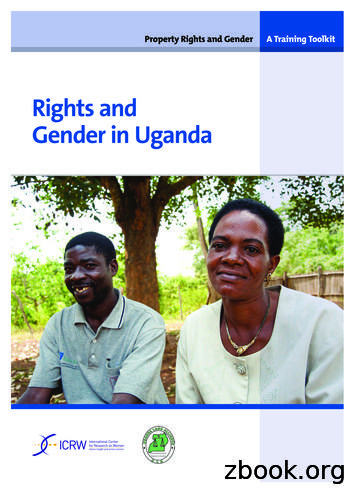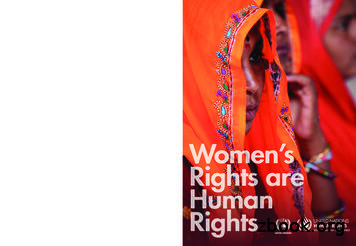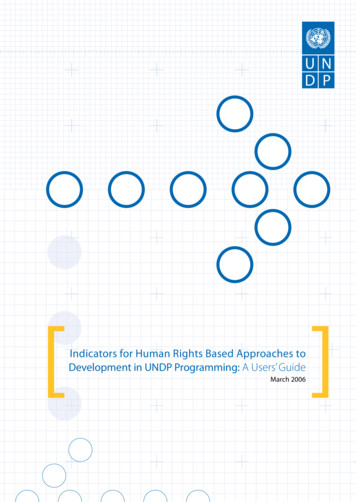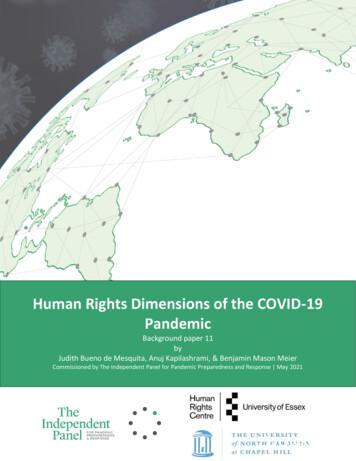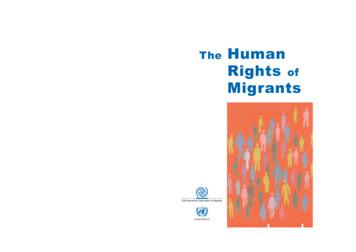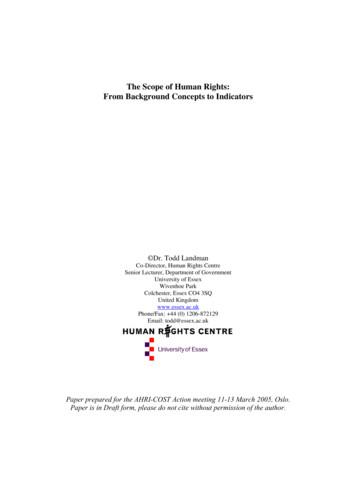Human Rights: A Brief Introduction - Harvard University
Human Rights:A Brief IntroductionStephen P. MarksHarvard University Harvard University 2016
Marks1Human RightsHuman Rights: A Brief IntroductionStephen P. MarksHarvard UniversityI: Introduction . 1II. Human rights in ethics, law and social activism . 1A. Human rights as ethical concerns . 2B. Human rights as legal rights (positive law tradition) . 3C. Human rights as social claims . 4III: Historical milestones . 5IV: Tensions and controversies about human rights today . 7A. Why do sovereign states accept human rights obligations? . 7B. How do we know which rights are recognized as human rights? . 8Table 1: List of human rights . 9C. Are human rights the same for everyone? . 11D. How are human rights put into practice? . 131. The norm-creating process . 13Table 2: Norm-creating process . 132. The norm-enforcing process . 143. Continuing and new challenges to human rights realization . 16Table 3: Means and methods of human rights implementation . 17V: Conclusion . 18Selected bibliography . 19Selected websites . 19Universal Declaration of Human Rights . 21I: IntroductionHuman rights constitute a set of normsgoverning the treatment of individuals andgroups by states and non-state actors on thebasis of ethical principles regarding whatsociety considers fundamental to a decentlife. These norms are incorporated intonational and international legal systems,which specify mechanisms and proceduresto hold the duty-bearers accountable andprovide redress for alleged victims of humanrights violations.After a brief discussion of the use ofhuman rights in ethical, legal and advocacydiscourse and some historical background ofthe concept of human rights, this essay willexamine the tensions between human rightsand state sovereignty, the challenges to theuniversality of human rights, theenumeration of rights recognized by theinternational community, and the meansavailable to translate the high aspirations ofhuman rights into practice.II. Human rights in ethics, law andsocial activismThere are numerous theoretical debatessurrounding the origins, scope andsignificance of human rights in political Harvard University 2016
Marks2science,moralphilosophy,andjurisprudence. Roughly speaking, invokingthe term “human rights” (which is oftenreferred to as “human rights discourse” or“human rights talk”) is based on moralreasoning (ethical discourse), sociallysanctioned norms (legal/political discourse)or social mobilization (advocacy discourse).These three types of discourse are by nomeans alternative or sequential but are allused in different contexts, depending onwho is invoking human rights discourse, towhom they are addressing their claims, andwhat they expect to gain by doing so. Thethree types of discourse are inter-related inthe sense that public reasoning based onethical arguments and social mobilizationbased on advocacy agendas influence legalnorms, processes and institutions and thusall three modes of discourse contribute tohuman rights becoming part of social reality.A. Human rights as ethical concernsHuman rights have in common anethical concern for just treatment, built onempathy or altruism in human behavior andconcepts of justice in philosophy. Thephilosopher and economist, Amartya Sen,considers that “Human rights can be seen asprimarily ethical demands Like otherethical claims that demand acceptance, thereis an implicit presumption in makingpronouncements on human rights that theunderlying ethical claims will survive openand informed scrutiny.”1In moralreasoning, the expression “human rights” isoften not distinguished from the moregeneral concept of “rights,” although in lawa “right” refers to any entitlement protectedby law, the moral validity or legitimacy ofwhich may be separate from its legal statusas an entitlement. The moral basis of a right1Amartya Sen, “Elements of a Theory of HumanRights,” Philosophy & Public Affairs, vol. 32, No. 4(2004), p. 320.Human Rightscan draw on concepts such as natural law,social contract, justice as fairness,consequentialism and other theories ofjustice. In all these philosophical traditions,a right is conceived as an entitlement ofindividuals, either by virtue of being humanor because they are members of a politicalcommunity (citizens). In law, however, aright is any legally protected interest,whatever the social consequence of theenforcement of the right on the wellbeing ofpersons other than the right-holder (e.g., theproperty right of a landlord to evict a tenant,the right of a business to earn profits). Toavoid confusion, it is helpful to use the term“humanright”oritsequivalent(“fundamental right,” “basic freedom,”“constitutional right”) to refer to a higherorder right, authoritatively defined andcarrying the expectation that it has aperemptory character and thus prevails overother (ordinary) rights and reflects theessential values of the society adopting it.Ethical and religious precepts determinewhat one is willing to accept as properly ahuman right. Such precepts are typicallyinvoked in the debates over current issuessuch as abortion, same-sex marriage, thedeath penalty, migration, much as they werearound slavery and inequality based onclass, gender or ethnicity in the past.Enlightenment philosophers derived thecentrality of the individual from theirtheories of the state of nature. Socialcontractarians, especially Jean-JacquesRousseau, predicated the authority of thestate on its capacity to achieve the optimumenjoyment of natural rights, that is, of rightsinherent in each individual irrespective ofbirth or status. He wrote in Essay on theOrigin on Inequality Among Men that “it isplainly contrary to the law of nature thatthe privileged few should gorge themselveswith superfluities, while the starvingmultitude are in want of the bare necessities Harvard University 2016
Marks3of life.”2 Equally important was the conceptof the universalized individual (“the rightsof Man”), reflected in the political thinkingof Immanuel Kant, John Locke, ThomasPaine and the authors of the AmericanDeclaration of Independence (1776) and theFrench Declaration of the Rights of Man andthe Citizen (1789). The Enlightenmentrepresents for the West both the affirmationof the scientific method with the relatedfaith of human progress and the formulationof the human rights, which define thefreedom and equality on which thelegitimacy of modern governments havehenceforth been judged. Karl Marx andmuch of socialist thinking questioned the“bourgeois” character of a limitedinterpretation of individual human rights andstressed community interests and egalitarianvalues.Human Rightsan constitutive characteristic of humanrights”3, implying an inherent value of theconcept of human rights, independent ofwhat is established in law. Legal positivistswould disagree and consider law to beconstitutive rather than declarative of humanrights.B. Human rights as legal rights (positivelaw tradition)Whether human rights discourse isessentially ethical and philosophical orrather essentially legal and political is amatter of dispute. Sen writes, “Even thoughhuman rights can, and often do, inspirelegislation, this is a further fact, rather than“Legal positivists” regard human rightsas resulting from a formal norm-creatingprocess, by which we mean an authoritativeformulation of the rules by which a society(national or international) is governed.While “natural rights” derive from naturalorder or divine origin, and are inalienable,immutable, and absolute, rights based on“positive law” are recognized through apolitical and legal process that results in adeclaration, law, treaty, or other normativeinstrument. These may vary over time andbe subject to derogations or limitationsdesigned to optimize respect for humanrights rather than impose an absolutestandard. They become part of the socialorder when an authoritative body proclaimsthem, and they attain a higher degree ofuniversality based on the participation ofvirtually every nation in the norm-creatingprocess, a process that is law-based but thatreflects compromise and historical shifts.Think of the moral and legal acceptability ofslavery, torture, or sexual and racialdiscrimination over most of human history.The product of what has survived “open andinformed scrutiny” (Sen’s expression) isthus often found not in journals andseminars on ethics and normative theory butrather at the end of the political or legislativeprocess leading to the adoption of laws andtreaties relating to human rights, such as therelatively recent abolition of slavery, torture23The ethical basis of human rights hasbeen defined using concepts such as humanflourishing, dignity, duties to family andsociety, natural rights, individual freedom,and social justice against exploitation basedon sex, class or caste. All of these moralarguments for human rights are part ofethical discourse. The tension ism,betweenLockeandRousseau, between liberty and equality,between civil and political rights andeconomic, social and cultural rights, havebeen part of the philosophical and politicalambiguity of human rights since thebeginning of the modern era.D.G.H. Cole translation, p. 117.Sen, supra, note 1, p. 319 Harvard University 2016
Marks4and discrimination based on race or sex.The “International Bill of HumanRights” (consisting of the UniversalDeclaration of Human Rights [UDHR] of1948, and two legally-binding treatiesopened for signature in 1966, namely, theInternational Covenant on Civil and PoliticalRights and the International Covenant onEconomic, Social and Cultural Rights),along with the other human rights treaties ofthe United Nations (UN) and of regionalorganizations, constitute the primary sourcesand reference points for what properlybelongs in the category of human rights.These legally recognized human rights arediscussed below in Part IV.B.C. Human rights as social claimsBefore they are written into legal texts,human rights often emerge from claims ofpeople suffering injustice and thus are basedon moral sentiment, culturally determinedby contextualized moral and religious beliefsystems. Revolt against tyranny is an ancienttradition. A modern precursor of socialmobilization for human rights at the nationallevel was the response to the unjustcondemnation of Captain Dreyfus in 1894 asa spy for the Germans, which led Emile Zolato proclaim in his famous “J’Accuse !”, animpassioned call to action that led to thecreation of the Ligue française des droits del’homme in 1897, and numerous similarleagues, which became federated in 1922 intothe International Federation of Leagues forthe Rights of Man (now the InternationalFederation for Human Rights), whichspawned its counterpart in the US in 1942, theInternational League for the Rights of Man,now functioning in New York as theInternational League for Human Rights.Amnesty International (founded in 1961), theMoscow Human Rights Committee (foundedin 1970), and Helsinki Watch (founded in1978 and expanded into Human Rights WatchHuman Rightsin 1988) were among the more effective nongovernmental organizations (NGOs). LatinAmerica, Africa and Asia saw the creation ofan extraordinary array of human rights groupsin the 1980s and 1990s, which haveproliferated after the end of the Cold War.These NGOs emerged as socialmovements catalyzed by outrage at themistreatment of prisoners, the exploitation ofworkers, the exclusion of women, children,persons with disabilities, or as part ofstruggles against slavery, the caste ion. Such movements for socialchange often invoke human rights as the basisof their advocacy. If the prevailing theories ofmoral philosophy or the extant codes ofhuman rights do not address their concerns,their action is directed at changing the theoryand the legal formulations. NGOs not onlycontributed to the drafting of the UDHR butalso in bringing down Apartheid,4transforming the political and legalconfiguration of East-Central Europe5 andrestoring democracy in Latin America.6 Newnorms emerged as a result of such socialmobilization during the second half of thetwentiethcenturyregardingselfdetermination of peoples, prevention andpunishment of torture, protection ofvulnerable groups and, more recently, equaltreatment of sexual minorities and protectionof migrants.The appeal to human rights in thisadvocacy discourse is no less legitimate thanthe legal and philosophical modes ofdiscourse and is often the inspiration for thelatter. Quoting Sen again, “The invoking of4William Korey, NGOs and the UniversalDeclaration of Human Rights: A Curious Grapevine,pp. 7-8.5Id., pp. 95-116.6Id., pp. 229-247. Harvard University 2016
Marks5human rights tends to come mostly fromthose who are concerned with changing theworld rather than interpreting it Thecolossal appeal of the idea of human rights[has provided comfort to those suffering]intense oppression or great misery, withouthaving to wait for the theoretical air toclear.”7Former British diplomat and lawprofessor Philip Allott expressed thetransformative potential of human rightswhen he found that there was, “room foroptimism on two grounds. (1) The idea ofhuman rights having been thought, it cannotbe unthought. It will not be replaced, unlessby some idea which contains and surpassesit. (2) There are tenacious individuals andnon-statal societies whose activity on behalfof the idea of human rights is not part ofinternational relations but is part of a newprocess of international reality-forming.”8He adds, “The idea of human rights shouldintimidate governments or it is worthnothing. If the idea of human rightsreassures governments, it is worse thannothing.”9 In sum, the force of socialmovements drawing inspiration from humanrights not only enriches the concept ofhuman rights but also contributes to alteringinternational society.III: Historical milestonesThe historical context of human rightscan be seen from a wide range ofperspectives.Attheriskofoversimplification, I will mention fourapproaches to the history of human rights.The first approach traces the deeper7Sen, supra, note 1, p. 317.8Philip Allott, Eunomia: New Order for a NewWorld, Oxford University Press, 1990, p. 287.9Id.Human Rightsoriginstoancientreligiousandphilosophical concepts of compassion,charity, justice, individual worth, andrespect for all life found in y and Islam. Precursors of humanrights declarations are found in the ancientcodes of Hammurabi in Babylon (about1772 BCE), the Charter of Cyrus the Greatin Persia (about 535 BCE), edicts of Ashokain India (about 250 BCE), and rules andtraditions of pre-colonial Africa and preColumbian America.10Others trace modern human rights to theemergence of natural law theories in AncientGreece and Rome and Christian theology ofthe Middle Ages, culminating in therebellions in the 17th and 18th centuryEurope,thephilosophersoftheEnlightenment and the Declarations thatlaunched the French and Americanrevolutions, combined with the 19th centuryabolitionist, workers’ rights and women’ssuffrage movements.11A third trend is to trace human rights totheir enthronement in the United NationsCharter of 1945, in reaction to the Holocaustand drawing on President Roosevelt’s FourFreedoms and the impact of the UniversalDeclaration of Human Rights of 1948 onsubsequent national constitutions andforeign policy and international treaties and10Micheline Ishay, The History of Human Rights:From Ancient Times to the Globalization Era, With aNew Preface, New York: Norton and Co., 2008. Seealso Micheline Ishay (ed.), The Human RightsReader: Major Political Essays, Speeches, andDocuments from Ancient Times to the Present,Second Edition, New York: Routledge, 2007.Another interesting compilation may be found inJeanne Hersch (ed.), Birthright of Man, UNESCO,1969. The French edition was published in 1968. Asecond edition was published in 1985.11Lynn Hunt, Inventing Human Rights: A History,New York: W. W. Norton & Company, 2007. Harvard University 2016
Marks6Human Rightsdeclarations.12ambiguous “Man” throughout.14A fourth view is the very recentrevisionist history that considers humanrights as peripheral in the aftermath ofWorld War II and only significant as autopian ideal and movement beginning inthe 1970s as an alternative to the prevailingideological climate.13Much scholarship, especially in Europeand North America, dates modern humanrights theory and practice from theEnlightenment and the transformativeinfluence of the French and AmericanRevolutions of the 18th century andliberation of subjugated people from slaveryand colonial domination in the 19th and 20thcenturies. Lynn Hunt, in an essay on “TheRevolutionary Origins of Human Rights,”affirms that:Most debates about rights originated inthe eighteenth century, and nowherewere discussions of them moreexplicit, more divisive, or moreinfluential than in revolutionaryFrance in the 1790s. The answersgiven then to most fundamentalquestions about rights remainedrelevant throughout the nineteenth andtwentieth centuries. The framers ofthe UN declaration of 1948 closelyfollowed the model established by theFrench Declaration of the Rights ofMan and Citizen of 1789, whilesubstituting “human” for the more12Paul Gordon Lauren, The Evolution ofInternational Human Rights: Visions Seen,Philadelphia: University of Pennsylvania Press, 1998;Hersch Lauterpacht, International Law and HumanRights, with an introduction by Isidore Silver. NewYork: Garland, 1950 (reprint 1973).13Samuel Moyn, The Last Utopia: Human Rights inHistory, Cambridge MA: Belknap Press of HarvardUniversity Press, 2012; Aryeh Neier, TheInternational Human Rights Movement: A History,Princeton, NY,: Princeton University Press 2012.CommentingontheFrenchRevolution’s break with the past, JürgenHabermas wrote that this “revolutionaryconsciousness gave birth to a new mentality,which was shaped by a new timeconsciousness, a new concept of ”Although it took morethan a century after the French Revolutionfor this new mentality to include women andpeople subjected to slavery, the awarenessthat the “rights of man” should extend to allhuman beings was forcefully argued in thesame period by Mary Wollstonecreaft’s AVindication of the Rights of Woman 16 and bythe Society for the Abolition of the SlaveTrade, founded in 1783. The valuation ofevery individual through natural rights was abreak with the earlier determination of rightsand duties on the basis of hierarchy andstatus. Concepts of human progress andhuman rights advanced in the 19th century,when capitalism and the industrialrevolution transformed the global economyand generated immense wealth at theexpense of colonized peoples and oppressedworkers. Human rights advanced but mainlyfor propertied males in Western societies.Since the 19th century, the human rights offormer colonialized peoples, women,14Lynn Hunt, ed., The French Revolution and HumanRights. A Brief Documentary History, Boston, NewYork: Bedord Boods of St. Martin’s Press, 1996, p. 3.See also Stephen P. Marks, “From the ‘SingleConfused Page’ to the ‘Decalogue for Six BillionPersons’: The Roots of the Universal Declaration ofHuman Rights in the French Revolution,” HumanRights Quarterly, vol. 20, No. 3, August 1998, pp.459-514.15Jürgen Habermas, Between Facts and Norms. AContribution to a Discourse Theory of Law andDemocracy, The MIT Press, Cambridge, MA, 1996,p. 467.16Mary Wollstonecreaft, A Vindication of the Rights ofWoman, (1792) Harvard University 2016
Marks7excluded minorities, and workers hasadvanced but the gap remains between thetheory of human rights belonging to all,regardless of race, sex, language, religion,political or other opinion, national or socialorigin, caste, property, birth or other status,and the reality of inequality anddiscrimination.The Second World War was thedefining event for the internationalization ofhuman rights. In 1940, H.G. Wells wroteThe Rights of Man or What are We FightingFor?; Roosevelt announced the “fourfreedoms” (freedoms of speech and worshipand freedoms from want and fear) in his1941 State of the Union address; the UNCharter established in 1945 an obligation ofall members to respect and observe humanrights and created a permanent commissionto promote their realization; the trial of Nazidoctors defined principles of bioethics thatwere codified in the Nuremberg Code in1946; and the Nuremberg Trials, in 1945–46, of 24 of the most important capturedleaders of Nazi Germany, establishedindividual criminal responsibility for masshuman rights violations. Each of theseevents connected with World War II has hadmajor repercussions for human rights today.In the War’s immediate aftermath, bedrockhuman rights texts were adopted: theGenocide Convention and the UniversalDeclaration of Human Rights in 1948, theGeneva Conventions in 1949 on theprotection of victims of armed conflict,followed in 1966 by the InternationalCovenants on Human Rights and scores ofUN and regional human rights texts onissues such as torture, the rights of the child,minorities, discrimination against women,and disability rights, along with the creationofinvestigativeandaccountabilityprocedures at the intergovernmental level.Individual criminal responsibility for massviolations of human rights re-emerged—after the hiatus of the Cold War—in the adHuman Rightshoc tribunals on Rwanda and formerYugoslavia and finally in the InternationalCriminal Court.IV: Tensions and controversiesabout human rights todayTo understand how human rights arepart of the global agenda, we need to ask (A)why states even accept the idea of humanrights obligations when they are supposed tobe sovereign and therefore do what theywant within their territory. Then we willexplore (B) what is the current list of humanrights generally accepted, before asking (C)whether they correspond to the basic valuesof all societies or are imposed from theoutside for ideological reasons. Finally, wewill examine (D) how they are transformedfrom word to deed, from aspiration topractice.A. Why do sovereign states accept humanrights obligations?The principle of state sovereigntymeans that neither another state nor aninternational organization can intervene in astate’s action to adopt, interpret and enforceits laws within its jurisdiction. Does thisprinciple of non-intervention in domesticaffairs of states mean that they are free toviolate human rights? Along with theprinciple of non-intervention, upon joiningthe United Nations, states have pledgedthemselves “to take joint and separate actionin co-operation with the Organization for theachievement of the purposes set forth inArticle 55,”17 which include the promotionof “universal respect for, and observance of,human rights and fundamental freedoms forall without distinction as to race, sex,language, or religion.”181718Article 56 of the UN Charter.Article 55 of the UN Charter. Article 1(3) of the Harvard University 2016
Marks8State sovereignty is therefore balancedwith legitimate concern of the internationalcommunity about human rights in allcountries. How that balance is interpretedvaries according to theories of internationalrelations. For those of the realist school (atheory that focuses on governments asautonomous and sovereign actors ininternational affairs, pursuing their nationalinterests through the projection of economic,military and political power, withoutconstraints of any superior authority orglobal government), only weak countries areunder any constraint to allow internationalscrutiny of their human rights performance.For the liberal internationalist, globalinstitutions and values, like human rights,matter more, although the internationalsystem is still based on state sovereignty.Theories of functionalism attach importanceto gradual political federation, beginningwith economic and social cooperation,especially through regional organizations.As these networks of interdependence grow,sovereign authority shifts to internationalinstitutions. Under the constructivist theoryof international relations, ideas, such ashuman rights, define international structure,which in turn defines the interests andidentities of states. Thus, social norms likehuman rights, rather than national security,can shape and progressively change foreignpolicy. In sum, as Richard Falk and othersargue, absolute sovereignty has given way tothe conception of “responsible sovereignty,”according to which sovereignty isconditional upon the state’s demonstrableadherence to minimum human rightsstandards and capacity to protect itscitizens.19Charter also includes “international co-operation inpromoting and encouraging respect for human rights”among the purposes of the UN.Human RightsThese realist, liberal internationalist,functionalist, and constructivist theories runalong a continuum from state-centricapproaches at one end (where nationalinterests prevail over any appeal to universalhuman rights), to cosmopolitanism at theother end (where identity with and supportfor equal rights for all people should holdstate sovereignty in check). In practice,states have accepted obligations to respectand promote human rights under the UNCharter and various human rights treaties,whatever their motivations, and, as a result,a regime has emerged in which human rightshave progressively become part of theaccepted standards of state behavior,functioning effectively in some areas andless so in others.Inordertounderstandthisphenomenon, it is useful to examine thecurrent set of recognized human rightsstandards.B. How do we know which rights arerecognized as human rights?While it is legitimate to draw onphilosophical arguments or activist agendasto claim any global social issue as a humanright, it is also useful to identify whichrights are officially recognized as such. Themost reliable source of the core content ofinternational human rights is found in theInternational Bill of Human Rights, whichenumerates approximately fifty normativepropositions on which additional humanrights documents have built. Scores ofregional and UN treaties have expanded thescope of recognized human rights, includingin specialized areas such as protection ofvictims of armed conflict, workers, refugeesand displaced persons, and persons withRoutledge, 2001, p. 69.19Richard A. Falk, Human Rights Horizons: ThePursuit of Justice in a Globalizing World, New York: Harvard University 2016
Marks9disabilities.The International Bill of Human Rightsenumerates five group rights, twenty-fourcivil and political rights (CPR), and fourteeneconomic, social and cultural rights (ESCR).It also sets out seven principles that explainhow the rights should be applied andinterpreted.The group rights listed in theInternational Bill of Human Rights includetwo rights of peoples (self-determinationand permanent sovereignty over naturalresources) and three rights of ethnic,religious and linguistic minorities (namely,the rights to enjoy one’s own culture, topractice one’s own religion, and to use one’slanguage).The civil and political rights includefive relating to physical integrity (rights tolife; freedom from torture; freedom fromslavery; freedom from arbitrary arrest ordetention; and the right to humane treatmentunder detention). Five other rights relate tothe individual’s autonomy of thought andaction (namely, freedom of movement andresidence; prohibition of expulsion of aliens;freedom of thought, conscience andreligious belief; freedom of expression; andthe right to privacy). Another four rightsconcern the administration of justice (nonimprisonment for debt; fair trial—for which16 additional rights are enumerated—; theright to personhood under the law; and theright to equality before the law). Six othercivil & political rights relate to participationin civil society (freedom of assembly;freedom of association; the right to marryHuman Rightsand found a family; rights of children; theright to practice a religion; and—as anexception to free speech—the prohibition ofwar propaganda and hate speech constitutingincitement). The final sub-set of these rightsis the four relating to political participation(namely, the right to
the concept of human rights, this essay will examine the tensions between human rights and state sovereignty, the challenges to the universality of human rights, the enumeration of rights recognized by the international community, and the means available to translate the high aspirations of human rights into practice. II.
Rights and gendeR in Uganda · 3 Rights & Human Rights Background Rights The law is based on the notion of rights. Community rights workers need to understand what rights are, where rights come from, and their own role in protecting and promoting rights. Community rights worker
A Human Rights Perspective by David Shiman Raising Children with Roots, Rights and Responsibilities: Celebrating the UN Convention on the Rights of the Child by Lori DuPont, Joanne Foley, and Annette Gagliardi Lesbian, Gay, Bisexual, and Transgender Rights: A Human Rights Perspective by David M. Donahue The Human Rights Education Handbook:
make up the International Bill of Human Rights. The provisions of the two Covenants, as well as other human rights treaties, are legally binding on . of their human rights, for example marriage and the family. 6 WOMEN’S RiGHTS ARE HUMAN RiGHTS The Convention defines d
stream human rights into development projects and to monitor and implement a human rights-based approach (HRBA) to development more generally. From the side of human rights, the demand has come from recognition among the human rights treaty monitoring bodies, the Office of the High Commissioner for Human Rights, and a variety of Special .
human rights impact of COVID-19 and COVID-19 responses on human rights; the role of global health and human rights governance actors, including the WHO, World Health Assembly, Office of the High Commissioner for Human Rights and UN human rights oversight bodies, suggesting areas of action for
consider the human rights dimension of contemporary migration. Under the Universal Declaration of Human Rights (created fifty years ago), human rights are universal (they apply everywhere), indivisible (political and civil rights cannot be separated from social and cultural rights); and inalienable (they cannot be denied to any human beings).
Introduction 1 1.The Scope of Human Rights 2 1.1. Categories of human rights 2 1.2. Dimensions of human rights 5 2. From Concepts to Indicators 10 3. Extant Measures 13 3.1. Rights in principle 13 3.2. Rights in practice 15 3.3. Government policies and outcomes 24 4. Lacun
One of the authors of this presentation is member of one of the user groups with access to TARGET2 data in accordance with Article 1(2) of Decision ECB/2010/9 of 29 July 2010 on access to and use of certain TARGET2 data.

